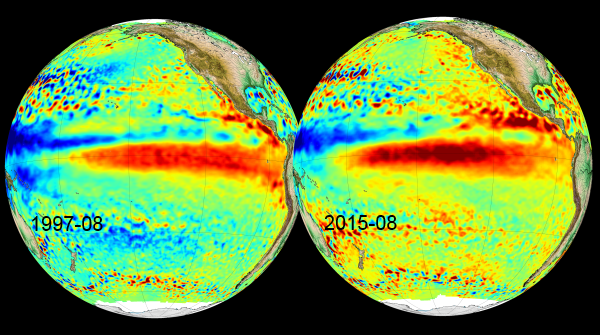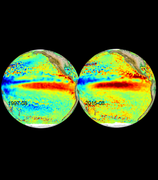News
01.09.2015 12:00 Age: 9 yrs
A strong El Niño this year ?
Category: Ocean and climate news
El Niño conditions are currently present. On August, anomalies of sea surface temperatures in the equatorial Pacific Ocean are above average of +2°C. If this anomaly persists during the next three months, a strong event would be reached.
Satellite altimetry, which measures sea surface height (which rises with higher temperatures during El Niño or falls with colder temperatures during La Niña), is vital for the early detection, analysis and close monitoring of these phenomena. Altimetry contributes to their forecasts. It is also an important asset to be able to better understand them, and thus better forecast them, including their intensity. With the continuity of altimetry since 1992, an unprecedented time series has been collected. Next satellites will help by ensuring continuity of observations, and improving data quality. An El Niño was announced early in May 2015. At this time, maps of Sea Level Anomalies showed large areas across the equatorial Pacific with above average. Sea Surface Temperature were also above-average on May 2015 and strengthenes across the east-central Pacific during summer. Those conditions were as high as observed during 1987 El-Niño, and thus forecasts are close to that episode. By keeping in mind, the last years when El Niño aborted, the 2015 event is examined in detail and particularly the atmospheric features. During July easterly winds were weaker than normal. The ocean-atmosphere coupling was in place: El Niño conditions are present. On August, anomalies of sea surface temperatures in the equatorial Pacific Ocean are above average of +2°C. If this anomaly persists during the next three months, a strong event would be reached. Models currently predict a strong event at its peak in late fall/early winter (2015).<media 14701 3000x1684 - "IMAGE, 201508 globe enso mean199708 vs 201508 HR, 201508_globe_enso_mean199708_vs_201508_HR.png, 5.5 MB"> </media> </media> |
Monthly mean of Sea Level Anomalies (annual and seasonal cycles removed)measured by altimetry over the Pacific for August 1997 (left) and August 2015 (right). Credits CNES/CLS. |
Further information:
- Indicators: <link internal-link>ENSO
- Applications: Climate, <link internal-link>ENSO
- Image of the month, July 2015 "<link internal-link>El Niño's return, west side story".
- ENSO current conditions on <link http: www.cpc.ncep.noaa.gov products precip cwlink mjo _blank external-link-new-window>CPC/NCEP website
- Météo France (2015/08/28): <link http: www.meteofrance.fr actualites _blank external-link-new-window>Vers un épisode El Niño de forte intensité (in french)





